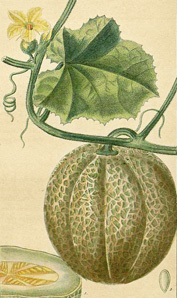Musky Muskmelon
By Audrey Stallsmith

What wondrous life is this I lead!. . .
The nectarine and curious peach
Into my hands themselves do reach;
Stumbling on melons, as I pass,
Ensnared with flowers, I fall on grass.
Andrew Marvell—“The Garden”
About the only summer we successfully grew melons here in Pennsylvania was the one in which we planted them on a slope near the pasture. Melons always seem to do better on new ground.
I’m guessing that maybe we should have stuck to that site, which was much more sunny and better drained than our long-used flat and increasingly shaded vegetable plot. Unfortunately, that former melon bed now is part of the sheep pasture.
Calling our muskmelons cantaloupes would be a mistake, since the latter were named for the town of Cantalupo near the Pope’s summer home in Italy. And European cantaloupes don’t have the netted “hide” with which we are familiar. Their rind, rather, tends to be smooth and deeply groove-y.
So we will stick with “muskmelon,” named for its musky perfume and for the Latin melopepo (“apple-shaped melon”), though most are oval rather than pome-shaped. The term muskmelon can also include the winter melons (honeydew, casaba, and Persian types) with their white or green flesh. It takes in less sweet varieties, too, whose flavor resembles that of cucumbers--including snake, Asian pickling, and mango melons.
Actually, even the orange-fleshed musks can be less sweet than they should be when they aren’t fully ripe or, for unknown reasons, just turn out less than scrumptious. We always let our purchased ones sit until we can smell them before we cut them open. For those which still aren’t tasty when mature, I’ve found that—oddly enough—adding a little salt often makes them seem more sugary.
Muskmelons like heat, since they originated in such toasty climates as Persia (now Iraq) and northwest India before being introduced to colder ones, where they often had to be grown “under glass.” Columbus carried seeds to the New World on his second voyage there, and they thrived in the Caribbean islands he visited. Ralph Waldo Emerson wrote that “I expand and live in the warm day like corn and melons.” Unlike some of us who are more irritable than expansive under hot conditions!
Because they are about 90 percent water, melons actually can make sizzling weather more tolerable by helping hydrate the sweaty humans who consume them. In addition, they supply plenty of Vitamin A and C without fat or many calories being involved! We probably should consider saving their seeds too, rather than tossing them in the garbage, since those seeds are a popular treat in the Mideast when dried and roasted.
And we probably should concur with Marvell that we do, indeed, live a wondrous life when we can partake so freely of fruits and vegetables year-round. Something that even long-ago kings and potentates couldn’t manage!
Cucumis melo image is from Flore Medicale des Antilles by M. E. Descourtilz, courtesy of plantillustrations.org.








